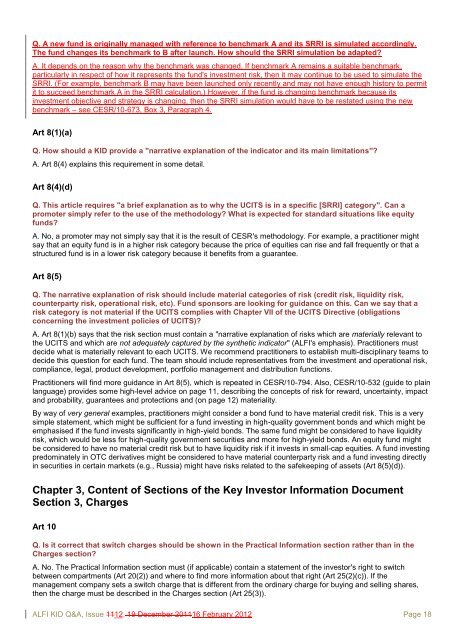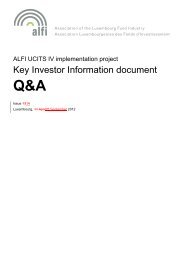Q&A - Alfi
Q&A - Alfi
Q&A - Alfi
Create successful ePaper yourself
Turn your PDF publications into a flip-book with our unique Google optimized e-Paper software.
Q. A new fund is originally managed with reference to benchmark A and its SRRI is simulated accordingly.<br />
The fund changes its benchmark to B after launch. How should the SRRI simulation be adapted?<br />
A. It depends on the reason why the benchmark was changed. If benchmark A remains a suitable benchmark,<br />
particularly in respect of how it represents the fund's investment risk, then it may continue to be used to simulate the<br />
SRRI. (For example, benchmark B may have been launched only recently and may not have enough history to permit<br />
it to succeed benchmark A in the SRRI calculation.) However, if the fund is changing benchmark because its<br />
investment objective and strategy is changing, then the SRRI simulation would have to be restated using the new<br />
benchmark – see CESR/10-673, Box 3, Paragraph 4.<br />
Art 8(1)(a)<br />
Q. How should a KID provide a "narrative explanation of the indicator and its main limitations"?<br />
A. Art 8(4) explains this requirement in some detail.<br />
Art 8(4)(d)<br />
Q. This article requires "a brief explanation as to why the UCITS is in a specific [SRRI] category". Can a<br />
promoter simply refer to the use of the methodology? What is expected for standard situations like equity<br />
funds?<br />
A. No, a promoter may not simply say that it is the result of CESR's methodology. For example, a practitioner might<br />
say that an equity fund is in a higher risk category because the price of equities can rise and fall frequently or that a<br />
structured fund is in a lower risk category because it benefits from a guarantee.<br />
Art 8(5)<br />
Q. The narrative explanation of risk should include material categories of risk (credit risk, liquidity risk,<br />
counterparty risk, operational risk, etc). Fund sponsors are looking for guidance on this. Can we say that a<br />
risk category is not material if the UCITS complies with Chapter VII of the UCITS Directive (obligations<br />
concerning the investment policies of UCITS)?<br />
A. Art 8(1)(b) says that the risk section must contain a "narrative explanation of risks which are materially relevant to<br />
the UCITS and which are not adequately captured by the synthetic indicator" (ALFI's emphasis). Practitioners must<br />
decide what is materially relevant to each UCITS. We recommend practitioners to establish multi-disciplinary teams to<br />
decide this question for each fund. The team should include representatives from the investment and operational risk,<br />
compliance, legal, product development, portfolio management and distribution functions.<br />
Practitioners will find more guidance in Art 8(5), which is repeated in CESR/10-794. Also, CESR/10-532 (guide to plain<br />
language) provides some high-level advice on page 11, describing the concepts of risk for reward, uncertainty, impact<br />
and probability, guarantees and protections and (on page 12) materiality.<br />
By way of very general examples, practitioners might consider a bond fund to have material credit risk. This is a very<br />
simple statement, which might be sufficient for a fund investing in high-quality government bonds and which might be<br />
emphasised if the fund invests significantly in high-yield bonds. The same fund might be considered to have liquidity<br />
risk, which would be less for high-quality government securities and more for high-yield bonds. An equity fund might<br />
be considered to have no material credit risk but to have liquidity risk if it invests in small-cap equities. A fund investing<br />
predominately in OTC derivatives might be considered to have material counterparty risk and a fund investing directly<br />
in securities in certain markets (e.g., Russia) might have risks related to the safekeeping of assets (Art 8(5)(d)).<br />
Chapter 3, Content of Sections of the Key Investor Information Document<br />
Section 3, Charges<br />
Art 10<br />
Q. Is it correct that switch charges should be shown in the Practical Information section rather than in the<br />
Charges section?<br />
A. No. The Practical Information section must (if applicable) contain a statement of the investor's right to switch<br />
between compartments (Art 20(2)) and where to find more information about that right (Art 25(2)(c)). If the<br />
management company sets a switch charge that is different from the ordinary charge for buying and selling shares,<br />
then the charge must be described in the Charges section (Art 25(3)).<br />
ALFI KID Q&A, Issue 1112, 19 December 201116 February 2012 Page 18

















